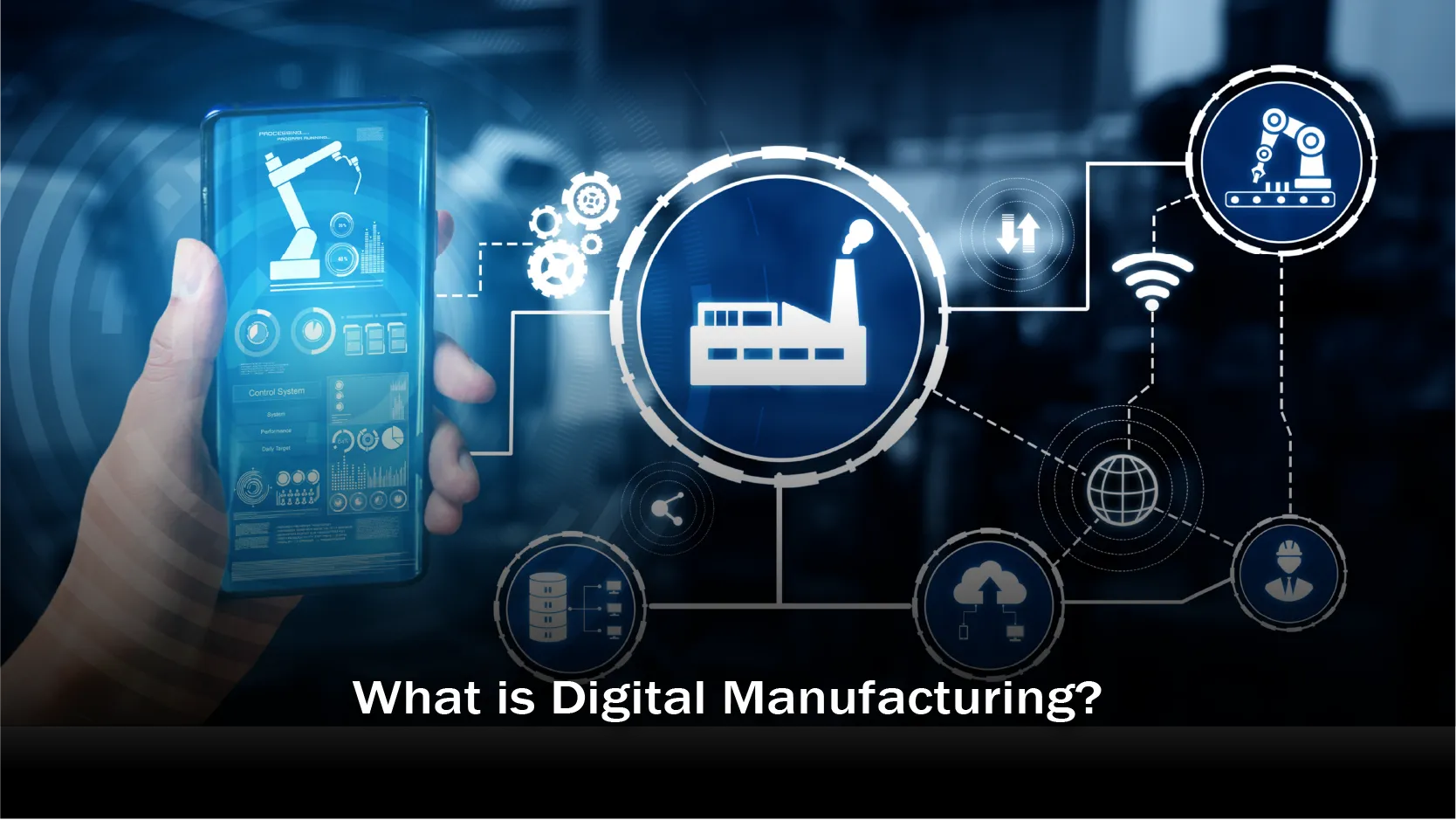As digital technologies are growing in importance in various industries worldwide, computer systems and other digital tools are being utilized to improve manufacturing processes. With these digital tools, real-time analysis can minimize challenges and inventory and reduce the time required for manufacturing products. Usually referred to as the fourth manufacturing revolution or Industry 4.0, the digital transformation of the production process allows enterprises to simplify production processes and be competitive in the global marketplace.
Read along the blog to learn more about what digital manufacturing is, what its key technologies and aspects are, and the hurdles in adoption.
What is Digital Manufacturing?

Digital manufacturing is an approach to integrating digital infrastructure (computer systems) into manufacturing execution, supply chain, operations, and product design. Digital manufacturing systems create a link between technologies and workflows throughout all the areas of production, from design to manufacturing execution and after services of final products.
It is now possible to enhance the quality of production-line decision-making by structuring and simulating manufacturing processes. This approach helps optimize operations to have significant cost savings, minimize time to market, and develop cohesive production strategies that centralize digital technologies with the physical execution of manufacturing.
Manufacturers can leverage a computer-driven approach to establish a digital thread throughout the entire production process. It enables them to analyze data across the product’s lifecycle and develop actionable strategies. Digital manufacturing solutions also facilitate the flow of customer insights directly to product managers, helping predict demand and anticipate maintenance needs, ensuring that the manufacturing process remains closely aligned with customer expectations.
Following are some key digital tools and technologies that digitize manufacturing execution:
● Cloud Computing
Cloud computing allows manufacturers to store, share, and access software solutions and analytics from anywhere in the world. This digital technology fosters seamless collaboration and scalability.
● Big Data and Analytics
Data-driven insights are crucial for manufacturing teams to improve operations, make smarter decisions, and optimize quality.
● 3D Printing
These digital technologies enable production units to quickly prototype, personalize, and develop complex parts with precision.
● Artificial Intelligence (AI) and Machine Learning (ML)
AI and ML are digital tools that allow production lines to evaluate data, control quality, enhance processes, and execute predictive maintenance.
● Internet of Things (IoT)
Manufacturing units can use sensors and devices to seamlessly connect machines and systems on the enterprise tech stack. IoT devices gather real-time data for monitoring and control.
● Robotics and Automation
Automated systems and robots are effective tools for executing repetitive tasks, improving efficiency, and minimizing human mistakes.
Also Read: Nanomaterials: A Beginner’s Guide to Understanding the World of Nanotechnology
What are the Key Aspects of Digital Manufacturing?

The entire digital manufacturing process can be divided into three key aspects, product life cycle, smart production lines, and managing its value chain.
Every aspect can be interlined to various aspects of manufacturing execution, from design and development, innovating products to improving production lines, and efficient utilization of resources for better product quality and client satisfaction.
The product life cycle starts from conception. It involves conceptualizing the design before shifting to the procuring, manufacturing, and service life of the product. Every phase utilizes digital information to enable revisions to design specifications during the manufacturing execution.
Smart manufacturing units include leveraging intelligent devices, sensors, and digital tools to offer real-time feedback about processes and production lines. Aligning operations technology (OT) with information technology (IT) provides better visibility of production lines and control and improves overall performance.
The management of the product value chain prioritizes minimizing the resources to develop the best manufacturing execution processes with minimal inventories without compromising product quality and client satisfaction.
Despite of vast array of technologies available, digitizing the manufacturing execution can be a daunting task.
What are the Bottlenecks of Embracing Digital Manufacturing?
In today’s fast-paced industrial landscape, the manufacturing units are where digital transformation comes with challenges and opportunities. This is shaping the future of manufacturing. Bygone are the days when production lines were dominated by manual tasks. Now, it is an ecosystem of connected devices, data analytics, and AI. Yet, digital transformation has become a buzzword with varied interpretations. Without a clear vision and leadership, traditional manufacturing processes will struggle to have a seamless transition.
● Technological Barriers
Managing the vast amount of generated data is overwhelming without the right analytical tools. Data must be efficiently processed to extract actionable insights. With increased data flow on the plant floor, robust cybersecurity has become critical to prevent breaches and protect sensitive information. Choosing technologies that evolve with business needs is key to avoiding obsolescence and ensuring flexibility.
● Organizational Hurdles
An undefined digital roadmap leads to poor technology adoption and inefficiencies. Lack of collaboration across departments can delay the seamless integration of digital solutions. Both employees and management might resist shifting to a digital plant floor. Adapting to new technology demands a cultural shift, which often clashes with familiar routines.
It is crucial to develop a culture open to changes. Engaging stakeholders and communicating the benefits of digitalization ensures a seamless transition. Successful digital transformation requires skilled workers to handle advanced systems. Enterprises should consider bridging this skill gap with effective training, which is crucial for success.
● Financial Bottlenecks
For smaller production lines, the upfront costs of digital adoption can be significantly high. For bigger manufacturing units, quantifying the returns on digital transformation investments can be complex for the decision-makers. It results in complicating budget decisions. Stakeholders need to have a strategic approach to balance these expenses with long-term gains.
Looking toward the Future
The lack of skilled resources to adopt smart technology tools and data governance systems is one of the significant challenges in the adoption of digital manufacturing. Along with that, financial and technological hurdles are making it more difficult to adapt to digital technologies in manufacturing executions. CIOs and CTOs need to work cohesively to overcome these hurdles to successfully embrace digital technologies in their production lines to achieve their organizational goals.




